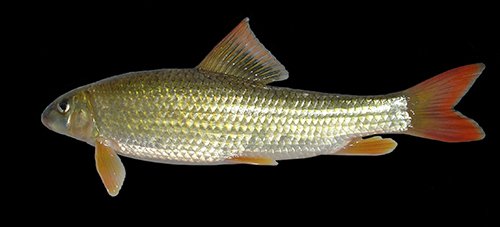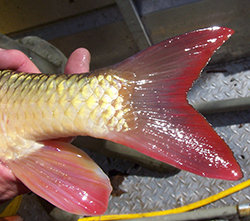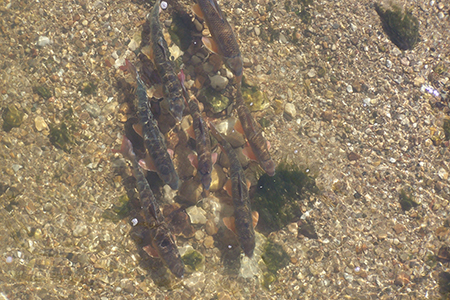Fisheries Blog
Although many of us know about the common game species, the non-game species are less well known — not surprising since it is tough to observe fish in their natural habitats. Illinois has over 200 fish species occupying a wide variety of waters, ranging from large rivers to small streams, and from small ponds to Lake Michigan. Our non-game species blog is highlighting those lesser-known Illinois species. We hope you enjoy the pictures and the information on their life histories, distribution, family ties, and other interesting facts about this fascinating group of animals.
 Shorthead Redhorse
Shorthead Redhorse
Moxostoma macrolepidotum
Shorthead Redhorse are a member of the sucker family known as Catostomidae, which as you know from a previous blog, contains 75 species worldwide. All but one of those species is found in the Western Hemisphere, with the greatest diversity occurring in Midwestern and Southeastern United States. There are 19 species of suckers in Illinois, representing eight different genera (groups of similar species). Suckers are one of the most prominent families in Illinois. In higher quality rivers and streams, they commonly dominate fish biomass. Suckers are frequently referred to as “rough fish,” because they are so abundant and superficially resemble Common Carp, which is actually in the minnow family. But as we learned before, suckers are way cooler. Many species in the sucker family are sensitive to habitat and water quality degradation and are an important component of river ecosystems. Shorthead Redhorse belongs to the genus Moxostoma. There are a total of six species of Redhorse in Illinois (stay tuned — maybe a future blog).
What’s in a name? It is interesting to look at the scientific name, which gives us clues about each species. For Shorthead Redhorse, the genus name, Moxostoma, if from the Greek language, meaning “mouth to suck;” the species name, macrolepidotum is Greek for “large scaled,” which Shortheads and other Redhorse have. Other common names include: Northern Redhorse, Redfin Sucker, Red Mullet, River Sucker, Brook Mullet, and Eastern Redhorse.
 Shorthead Redhorse have a slender, elongate body, which is nearly round in cross-section. As their common name implies, they have a smaller head and mouth compared to other Redhorse species. Shape and size of the lips is often used as a distinguishing characteristic for Redhorse identification (see Moxostoma.com). Shorthead’s smaller lips have a straight rear margin on the lower lip, compared to a “V” shaped lower lip in other Redhorse species. Shorthead Redhorse have a bright red caudal fin, similar to Greater and River Redhorse, both of which are rare species on the Illinois Threatened and Endangered List. Both of these rare Redhorse species have much larger heads and mouths with “V” shaped lower lips, as well as a larger overall body size as adults. Shorthead Redhorse adults are usually in the 15- to 20-inch length range, but can be larger. Their life span is typically less than 10 years.
Shorthead Redhorse have a slender, elongate body, which is nearly round in cross-section. As their common name implies, they have a smaller head and mouth compared to other Redhorse species. Shape and size of the lips is often used as a distinguishing characteristic for Redhorse identification (see Moxostoma.com). Shorthead’s smaller lips have a straight rear margin on the lower lip, compared to a “V” shaped lower lip in other Redhorse species. Shorthead Redhorse have a bright red caudal fin, similar to Greater and River Redhorse, both of which are rare species on the Illinois Threatened and Endangered List. Both of these rare Redhorse species have much larger heads and mouths with “V” shaped lower lips, as well as a larger overall body size as adults. Shorthead Redhorse adults are usually in the 15- to 20-inch length range, but can be larger. Their life span is typically less than 10 years.
 Shorthead Redhorse are found primarily in medium to large rivers. They are most abundant in moderate to higher gradient streams. They are also found, although in lower abundance, in lower gradient habitats, such as the upper Kankakee River, large floodplain rivers (e.g., Illinois River) and Lake Michigan. Their food includes insect larvae and other macroinvertebrates. Most adults reach sexually maturity at age five, although some males may spawn as early as age three. All their fins become bright red during spawning, and males form small, rough “bumps,” known as spawning tubercles, on their anal fin and lower caudal fin. Shorthead Redhorse spawning behavior is one of the most interesting aspects of their natural history. Spawning typically begins in late March or early April, with large migrations into tributary creeks. Eggs are deposited in constructed nests, which are located in areas of moderate flow. Large aggregates of up to 40 nests have been observed. Nests are constructed by vigorous tail fanning to scour away the finer surface substrate, creating a large mound of finer gravel and sand immediately downstream of each nest. Juvenile Shorthead’s typically exit the tributaries returning to the larger river mainstem by late fall.
Shorthead Redhorse are found primarily in medium to large rivers. They are most abundant in moderate to higher gradient streams. They are also found, although in lower abundance, in lower gradient habitats, such as the upper Kankakee River, large floodplain rivers (e.g., Illinois River) and Lake Michigan. Their food includes insect larvae and other macroinvertebrates. Most adults reach sexually maturity at age five, although some males may spawn as early as age three. All their fins become bright red during spawning, and males form small, rough “bumps,” known as spawning tubercles, on their anal fin and lower caudal fin. Shorthead Redhorse spawning behavior is one of the most interesting aspects of their natural history. Spawning typically begins in late March or early April, with large migrations into tributary creeks. Eggs are deposited in constructed nests, which are located in areas of moderate flow. Large aggregates of up to 40 nests have been observed. Nests are constructed by vigorous tail fanning to scour away the finer surface substrate, creating a large mound of finer gravel and sand immediately downstream of each nest. Juvenile Shorthead’s typically exit the tributaries returning to the larger river mainstem by late fall.
Sucker species were known as an important food source for Indigenous Americans. The large spring spawning runs of Shorthead Redhorse made them an attractive target. In fact, a dam built by white settlers blocked the spawning migrations on Indian Creek (Fox River, LaSalle County) and led to a conflict with the local Potawatomi villages (https://en.wikipedia.org/wiki/Indian_Creek_massacre). Shorthead Redhorse can be taken by hook and line using worms and grubs on a small hook. They have a very light and tender flesh, however, there are many bones present. Please be sure not to confuse Shorthead Redhorse with the state-listed Greater and River Redhorse when angling.



